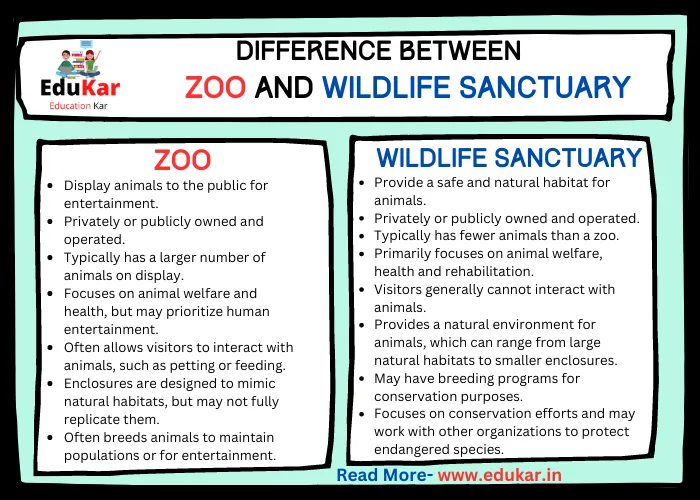Contents
- 1 Introduction
- 2 Zoo
- 3 Wildlife Sanctuary
- 4 Differences between Zoo and Wildlife Sanctuary
- 5 Summary
- 6 FAQs
- 6.1 What is a Zoo?
- 6.2 What is a Wildlife Sanctuary?
- 6.3 What is the main difference between a zoo and a wildlife sanctuary?
- 6.4 Do wildlife sanctuaries have exhibits or shows?
- 6.5 Can I visit a wildlife sanctuary?
- 6.6 Are animals kept in enclosures in wildlife sanctuaries?
- 6.7 Which is better for animal welfare, a zoo or a wildlife sanctuary?
Learn about the key differences between a zoo and a wildlife sanctuary in this informative article by Edukar. Discover how each type of facility operates and their varying goals for animal care and conservation. Gain a deeper understanding of the important role they play in protecting and preserving wildlife around the world.

Introduction
Zoos and wildlife sanctuaries are often confused as being the same, but in fact, they are quite different. Zoos and wildlife sanctuaries are both facilities that house animals, but their purposes and methods of operation are different. Zoos are designed to entertain and educate visitors, while wildlife sanctuaries are focused on the care and rehabilitation of animals. It’s important to understand the differences between the two, so that visitors can make informed choices when visiting animal facilities.
Zoo
A zoo is a facility that houses animals for public display, entertainment, and educational purposes. Zoos have been around for centuries, and were initially designed as menageries for royalty and the wealthy. Today, zoos are more commonly run by governments or non-profit organizations, and are open to the public.
Purpose of Zoo
The main purpose of zoos is to educate and entertain the public. Zoos offer visitors a chance to see exotic animals up close, and to learn about different species and their habitats. Many zoos also offer educational programs, such as guided tours, animal encounters, and classroom lessons.
Also Read: Difference Between Mountain and Plateau
Advantages and Disadvantages of Zoo
One advantage of zoos is that they provide an opportunity for people to see animals they might not otherwise get to see. Zoos also help to promote animal conservation efforts by raising awareness about endangered species and their habitats. Zoos can also be a fun and educational experience for children.
One disadvantage of zoos is that they can be stressful and unhealthy for animals. Zoos often house animals in small enclosures, which can lead to boredom, depression, and physical ailments. Animals in zoos may also experience social isolation, as they are often separated from their natural social groups.
Examples of Popular Zoos
Some of the most popular zoos in the world include
- Mysore Zoo, Mysore.
- Rajiv Gandhi Zoological Park, Pune.
- Indira Gandhi Zoological Park, Visakhapatnam.
- Nehru Zoological Park, Hyderabad.
- Nandankanan Zoological Park, Bhubaneswar.
- Arignar Anna Zoological Park, Chennai.
Wildlife Sanctuary
A wildlife sanctuary is a facility that provides a safe haven for animals that have been injured, abandoned, or mistreated. Wildlife sanctuaries focus on the care and rehabilitation of animals, and often work with government agencies and other organizations to protect wildlife and their habitats.
Purpose of Wildlife Sanctuariy
The main purpose of wildlife sanctuaries is to provide a safe and natural environment for animals to live and thrive. Wildlife sanctuaries also work to protect endangered species and their habitats, and often engage in research and educational programs.
Advantages and Disadvantages of Wildlife Sanctuary
One advantage of wildlife sanctuaries is that they provide a safe and natural environment for animals to live in. Wildlife sanctuaries also work to rehabilitate animals and release them back into the wild, when possible. Many wildlife sanctuaries also have educational programs that teach visitors about the importance of wildlife conservation.
One disadvantage of wildlife sanctuaries is that they can be expensive to operate and maintain. Wildlife sanctuaries also may not have as many animals on display as zoos, which can be disappointing for visitors.
Also Read: Difference Between Western Ghats and Eastern Ghats
Examples of Popular Wildlife Sanctuaries
Some of the most popular wildlife sanctuaries in the world include:
- Bharatpur Bird Sanctuary, Rajasthan.
- Chilika Lake Bird Sanctuary, Odisha.
- Chinnar Wildlife Sanctuary, Kerala.
- Gir National Park and Wildlife Sanctuary, Gujarat.
- Govind Wildlife Sanctuary, Uttarakhand.
- Madumalai Sanctuary, Tamil Nadu
Differences between Zoo and Wildlife Sanctuary
| Criteria | Zoo | Wildlife Sanctuary |
|---|---|---|
| Purpose | Display animals to the public for entertainment | Provide a safe and natural habitat for animals |
| Ownership | Privately or publicly owned and operated | Privately or publicly owned and operated |
| Number of animals | Typically has a larger number of animals on display | Typically has fewer animals than a zoo |
| Animal care | Focuses on animal welfare and health, but may prioritize human entertainment | Primarily focuses on animal welfare, health and rehabilitation |
| Animal interactions | Often allows visitors to interact with animals, such as petting or feeding | Visitors generally cannot interact with animals |
| Habitat | Enclosures are designed to mimic natural habitats, but may not fully replicate them | Provides a natural environment for animals, which can range from large natural habitats to smaller enclosures |
| Breeding programs | Often breeds animals to maintain populations or for entertainment | May have breeding programs for conservation purposes |
| Conservation efforts | May participate in conservation efforts, but this is not always a primary focus | Focuses on conservation efforts and may work with other organizations to protect endangered species |
| Funding sources | Relies heavily on admission fees and commercial activities | May rely on donations, grants, and government funding |
| Visitor experience | Emphasizes the entertainment value for visitors, with exhibits and attractions | Emphasizes education and may offer guided tours, educational programs, and research opportunities |
Summary
Zoos and wildlife sanctuaries share a common goal of protecting and preserving animal species, they differ in their approach and purpose.
Zoos are primarily focused on education and entertainment, often featuring a wide variety of species from around the world in exhibits designed to mimic their natural habitats. Wildlife sanctuaries are primarily focused on providing a safe and natural environment for animals that have been rescued from illegal trade, abuse, or neglect. These sanctuaries provide animals with the opportunity to live in a more natural setting and often offer educational programs as well.
Also Read: Difference Between Tropical Evergreen and Deciduous Forest
FAQs
What is a Zoo?
A zoo is a facility where animals are kept in enclosures or exhibits for public display, entertainment, and education.
What is a Wildlife Sanctuary?
A wildlife sanctuary is a protected area where animals are kept in their natural habitat, away from human interference and exploitation.
What is the main difference between a zoo and a wildlife sanctuary?
The main difference between a zoo and a wildlife sanctuary is that zoos are primarily designed for public display and entertainment, while wildlife sanctuaries are designed to protect and conserve the natural habitat and ecosystem of animals.
Do wildlife sanctuaries have exhibits or shows?
Wildlife sanctuaries do not have exhibits or shows as their primary focus is to provide a natural habitat for animals and protect them from human interference.
Can I visit a wildlife sanctuary?
Yes, visitors are allowed in some wildlife sanctuaries, but the focus is on observing the animals in their natural habitat, rather than entertainment.
Are animals kept in enclosures in wildlife sanctuaries?
While animals may be kept in some form of enclosure in a wildlife sanctuary, the focus is on providing them with a natural and safe habitat that closely resembles their natural environment.
Which is better for animal welfare, a zoo or a wildlife sanctuary?
Wildlife sanctuaries are generally considered better for animal welfare as they provide a natural habitat for the animals and minimize human interference. However, some zoos may also prioritize animal welfare and have programs in place to provide appropriate care for the animals.








